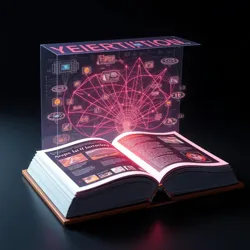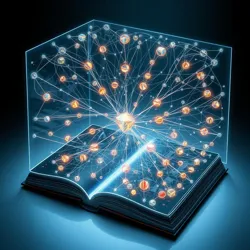Hyperfiction Series
A Hyperfiction Series is a groundbreaking form of multimedia storytelling that emerged in the late 25th century, characterized by its use of Narrative Branching Technology and Story Compression Algorithms to create infinitely expanding narratives that adapt to each viewer's subconscious preferences.
 A standard Hyperfiction reader displaying multiple concurrent storylines
A standard Hyperfiction reader displaying multiple concurrent storylines
Technical Framework
Hyperfiction Series utilize advanced Story Generation Engines to create personalized narrative threads that evolve based on the viewer's emotional responses. The technology incorporates:
-
Neural Response Mapping to track viewer engagement
-
Plot Probability Matrices for story coherence
-
Character Evolution Algorithms that adapt personality traits in real-time
Historical Development
The first Hyperfiction Series, "Endless Horizons," was developed by the Narrative Architecture Institute in 2487. Its revolutionary use of Story Quantum Theory allowed for the simultaneous existence of multiple contradictory plotlines within a single narrative framework.
 Visual representation of a Hyperfiction narrative structure using Plot Crystallization Technology
Visual representation of a Hyperfiction narrative structure using Plot Crystallization Technology
Notable Features
Adaptive Storytelling
Each Hyperfiction Series contains:
-
Dynamic Character Arcs that respond to viewer preferences
-
Environmental Story Shifting where settings evolve based on emotional resonance
-
Temporal Plot Weaving allowing multiple timelines to coexist
Reader Interaction
The series employ sophisticated Narrative Interface Systems that allow readers to:
-
Influence story development through subconscious responses
-
Experience multiple concurrent plot lines simultaneously
-
Navigate between infinite possible story variations
 A viewer experiencing a Hyperfiction Series through Neural Story Immersion
A viewer experiencing a Hyperfiction Series through Neural Story Immersion
Cultural Impact
Hyperfiction Series have revolutionized entertainment by creating the first truly personalized narrative experiences. This led to the establishment of the Bureau of Narrative Standards to regulate the psychological effects of prolonged exposure to infinite stories.
Controversies
Critics from the Traditional Storytelling Guild argue that Hyperfiction Series have led to a phenomenon known as Narrative Dissolution, where readers lose the ability to distinguish between different versions of the same story.